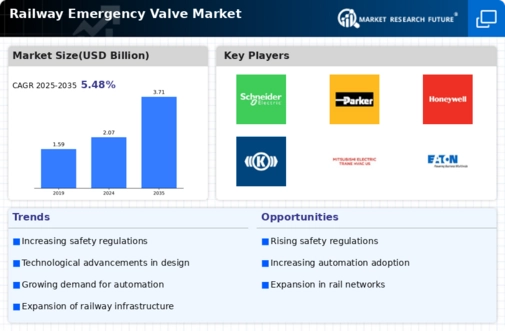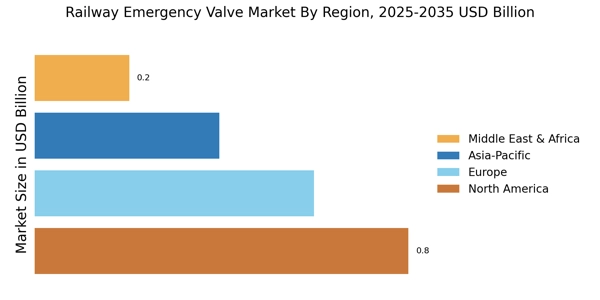Technological Innovations
Technological innovations play a pivotal role in shaping the Railway Emergency Valve Market. The advent of smart technologies, such as automated monitoring systems and IoT integration, has revolutionized the functionality of emergency valves. These innovations not only enhance the operational efficiency of railway systems but also improve safety protocols. For instance, real-time data analytics can predict potential failures, allowing for timely interventions. The market is expected to witness a significant increase in demand for technologically advanced emergency valves, with projections indicating a growth rate of around 6% annually as rail operators seek to modernize their infrastructure.
Increasing Safety Regulations
The Railway Emergency Valve Market is experiencing a surge in demand due to the increasing safety regulations imposed by various authorities. Governments and regulatory bodies are emphasizing the need for enhanced safety measures in railway systems. This has led to a greater focus on the installation of emergency valves, which are crucial for preventing accidents and ensuring passenger safety. As a result, manufacturers are investing in advanced technologies to meet these regulatory requirements. The market is projected to grow at a compound annual growth rate of approximately 5.2% over the next few years, driven by these stringent safety standards.
Focus on Environmental Sustainability
The Railway Emergency Valve Market is increasingly aligning with the focus on environmental sustainability. As the world shifts towards greener transportation solutions, railways are being recognized for their lower carbon footprint compared to other modes of transport. This has prompted railway companies to adopt more sustainable practices, including the use of eco-friendly materials in the manufacturing of emergency valves. Furthermore, regulatory pressures to reduce emissions are driving innovation in the design and functionality of these valves. The market is anticipated to grow as companies strive to meet sustainability goals, with projections indicating a potential increase in demand by 5% annually.
Growing Investment in Rail Infrastructure
The Railway Emergency Valve Market is benefiting from the growing investment in rail infrastructure across various regions. Governments are recognizing the importance of rail transport in promoting economic growth and reducing traffic congestion. This has led to substantial funding for railway projects, which includes the installation of emergency valves as part of safety enhancements. According to recent reports, investments in rail infrastructure are expected to reach USD 200 billion by 2027, creating a favorable environment for the emergency valve market. This influx of capital is likely to stimulate demand for high-quality emergency valves, thereby driving market growth.
Rising Demand for Efficient Transportation
The Railway Emergency Valve Market is also influenced by the rising demand for efficient transportation solutions. As urbanization continues to accelerate, there is an increasing need for reliable and safe public transport systems. Railways are often viewed as a sustainable alternative to road transport, leading to a higher passenger volume. Consequently, railway operators are prioritizing safety measures, including the installation of emergency valves, to ensure the protection of passengers. This trend is expected to contribute to a steady growth in the market, with estimates suggesting an annual growth rate of approximately 4.5% as operators seek to enhance their service offerings.


















Leave a Comment